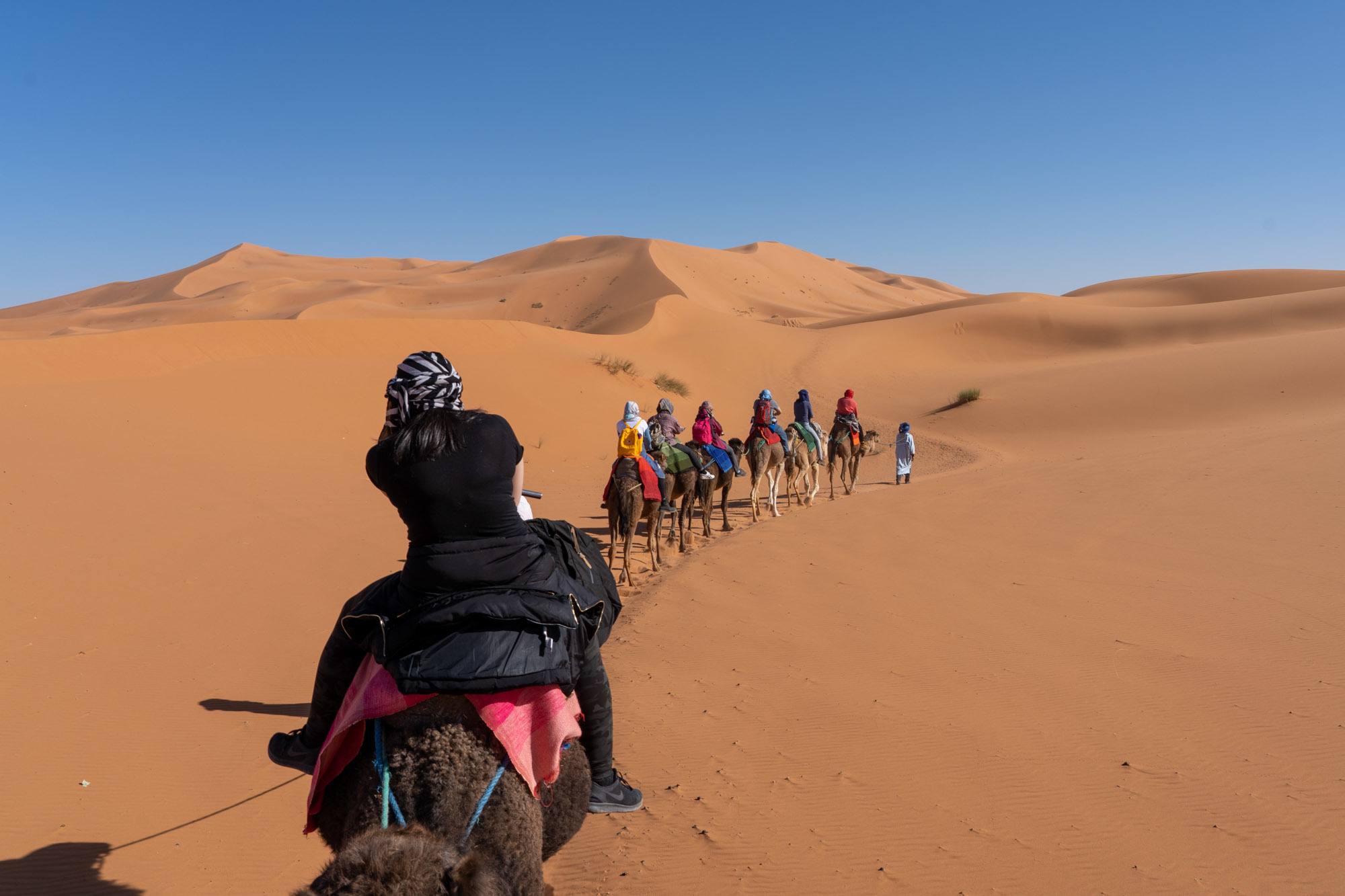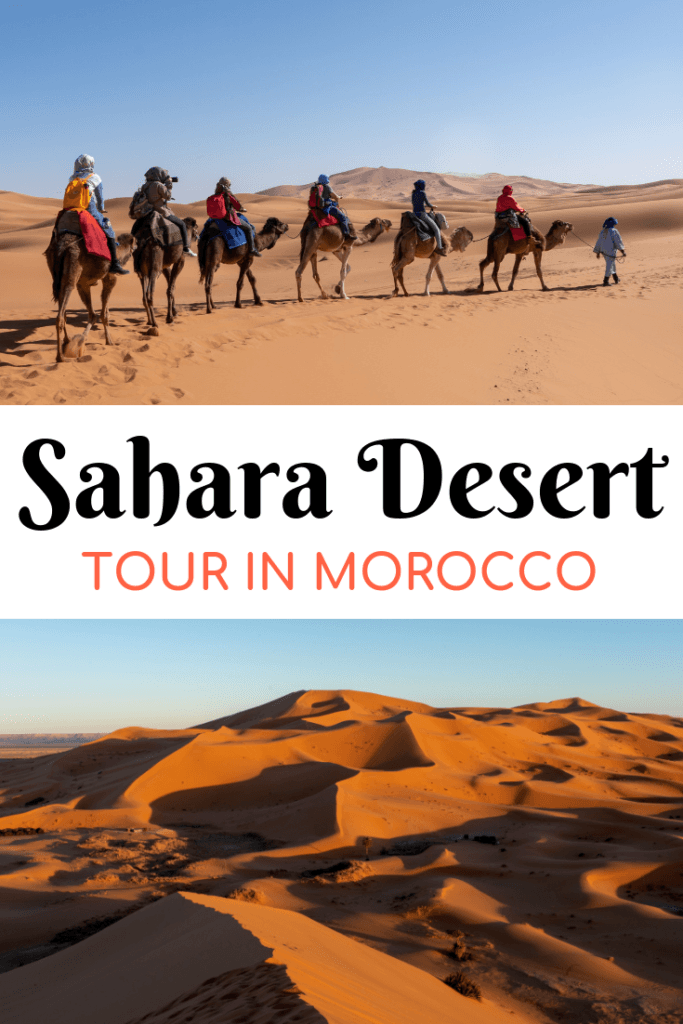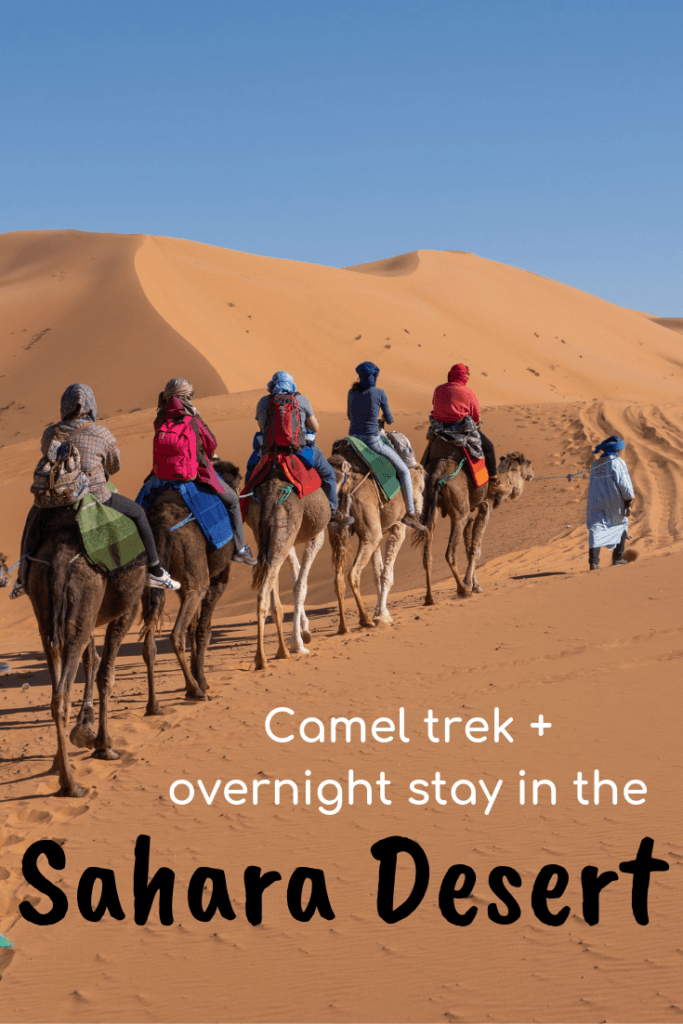Camels, Dunes, and Drums: An Overnight Trip into the Sahara Desert

I was about a quarter of the way up the dune, my lungs burning and my boots slowly filling up with sand when I remembered something I always manage to forget: climbing sand dunes really sucks.
Standing at the bottom of a sand dune, it never really looks *that* high. You tell yourself you can easily climb it; that all those kickboxing classes surely have prepared you for this moment.
You start climbing, feeling good. But then you literally get “that sinking feeling” as you sink at least one step backward for every two you take forward; the top never seems to get any closer.
But when you find yourself in the Sahara Desert just before sunset, you can't NOT climb the dune.

Climbing a golden sand dune for sunset was just one of the many highlights of my trip into the Sahara Desert in Morocco. Doing a trip like this has been on my bucket list for years, and I'm happy to report that it 100% lived up to all my expectations!
Riding camels into the Sahara Desert
Our journey began at a desert hotel called Hotel Yasmina just outside of the town of Merzouga. The hotel is situated right on the western edge of the Erg Chebbi, a large “sea” of sand dunes not far from the Algeria border.
My group arrived at the hotel in the late afternoon, brimming with excitement as we caught our first glimpse of waiting camels.

After a quick break to make sure we all had our day packs ready for our overnight adventure, we were soon frolicking out into the sand to be paired up with our four-legged rides.
Now, I've ridden plenty of horses before. But I knew from doing some reading that riding a camel is NOTHING like riding a horse. First of all, camels sit substantially higher off the ground than a horse does. Secondly, you get on a camel while it's laying down on the ground, and then are basically catapulted up in the air as they rise quickly.
Also, they move nothing like horses.

Horses walk by moving one front leg and the opposite back leg at the same time. Camels, conversely, have a lateral gait, meaning they move both legs on the same side together. This makes riding a camel infinitely more uncomfortable.
Riding a camel is kind of like lolling around on a large barrel with legs, constantly feeling like your saddle might be slipping off. Or, at least, that's what riding Alexander Camelton (yes, I named him) felt like.
Yet I loved every second of it. I was giggling and grinning the whole time as we plodded awkwardly across the sand dunes under the afternoon sun. It was worth every sore muscle that I'd be feeling 2 days later.



Our ride to our desert camp took a little over an hour.
During the hotter summer months, people usually make this ride right at sunset as the desert starts to cool off. But since I visited in March when the days weren't very hot yet, we made our ride just prior to the magical desert “golden hour.”

Sand dune sunset
After arriving and squeeing a bit over our camp (real mattresses! flush toilets! super photogenic lanterns!), I took some camel selfies while most of the rest of my group started climbing up the largest dune near our camp.

This meant that when I started my ascent about 15 minutes later, I had no motivation to continue climbing beyond the first 100 meters or so. (Remember: climbing sand dunes sucks!)

It meant I missed out on watching the sun set from higher up in the dunes with the rest of my group, but I wasn't exactly complaining when I had these views entirely to myself.




The Erg Chebbi dunes are dotted all over with permanent tented camps like ours – our guide said there were probably at least 100 in the Merzouga area. The nice thing is that none of the camps are too huge; in fact, my small group of 6 had our camp entirely to ourselves!
Once I watched the dunes turn from gold to amber to pink to a dull brown, I half-walked, half-slid back down the dune to camp, where the lanterns were starting to twinkle and dinner was waiting.

Overnight in the Sahara Desert
I've camped overnight in the desert before (in Namibia), but an overnight trip into the Sahara Desert in Morocco is so much more than just sleeping in a tent in the desert.
First, we had dinner in the main tent around a large table – rice and olives and a meat and veggie tagine – and then went back outside to huddle around the fire on padded cushions and chairs. Our local Berber guides built up the fire, and then brought out drums and we listened to them sing as the stars came out overhead.
We pointed out constellations and passed around bottles of wine procured earlier in the trip, and listened as drums sounded from other nearby camps. It was almost like the Sahara came alive with music after dark.

Traveling to the desert at the end of February meant it got cold after the sun went down, so we were all tucked into our beds under thick wool blankets by about 10 p.m. This was actually something I remembered loving about my overland trip through Africa a couple years ago: You stayed up until the fire went out, and woke with the sunrise.
We actually woke before the sun the next day in order to be on our camels again for sunrise. We rode out of the desert as the sun climbed above the horizon, stopping briefly for photos as the sun changed the dunes from brown to pink to orange.


I'll never forget how that sunrise cast long, spindly-legged shadows of our camels in the sand, or how sorry I was when Hotel Yasmina came back into view.

This truly was a bucket list adventure!
RELATED: 8 Things That Surprised Me About Traveling in Morocco
What you need to know about Sahara trips in Morocco
And now, all the practical stuff you might want to know before taking a trip into the Sahara Desert!
Where is the Sahara Desert?
The Sahara Desert covers a large part of the African continent – more than 3.5 million square miles, in fact. But only a small part of it is in Morocco. The Moroccan Sahara is located in the south and east of the country, mostly along the border with Algeria.

Getting to the Sahara in Morocco isn't exactly easy – it's not close to any of the major cities you can fly into, and most tours from Marrakech or Fes will require 2-3 days. (If someone tries to sell you a 1-day desert tour from Marrakech, you will NOT be visiting the Sahara; you need to cross the High Atlas mountains to reach the Sahara from Marrakech, and this can”t be done in one day!)
How to book a Sahara Desert tour
My overnight Sahara trip was part of a larger Morocco tour that I did with Intrepid Travel. But trips like this are very popular in Morocco, and are easy to book from major cities like Marrakech and Fes. Just know that if you book a stand-alone Sahara tour from one of these cities, they can last anywhere from 2-5 days depending on the itinerary and which part of the Sahara you're going to visit.
The part of the Sahara closest to Marrakech is the Erg Chigaga, or Zagora Desert, which is about 220 miles from Marrakech. You can do a trip to this part of the Sahara on a 2-day trip.
But the part of the Sahara you've seen in photos – the part with the big golden-orange sand dunes – is near Merzouga in the southeast of the country. The Erg Chebbi sand dunes that I mentioned before are more than 340 miles from Marrakech, requiring a multi-day trip to visit them.

The good news is that if you book a multi-day trip to the Sahara Desert, you'll stop at other places along the way like the ksar of Aït-Ben-Haddou, the Valley of Roses, and the Todra Gorge.
Sahara tours to check out
These multi-day Sahara tours are some of the top-rated ones:
What are the campsites like?
There are hundreds of campsites in the Sahara Desert that cater to both tourists and Moroccans on vacation. The campsites vary in size, but in general are quite similar. They have large tents (big enough to stand up in), often with real mattresses or even full beds to sleep on.
The camp I stayed at (the Hotel Yasmina Desert Camp) also had Western-style flush toilets. There were no shower facilities in the desert, but thankfully it was dry and cool at night, so nobody in my group minded this.

I'd say our camp was a mid-range one; not a budget camp, but not a super-luxe one, either.
Is riding a camel humane?
The more I travel, the more aware I become of how my actions and decisions affect the world around me. I've become more conscious of the environmental impact of my travels, and have also tried to educate myself on responsible tourism – as it pertains to both people AND wildlife.
There are some animal encounters that are just downright a no-go for me – like riding elephants or swimming with dolphins in captivity. But then there are others that lie in the gray area. And riding camels in the desert could be one of those gray-area things.

Camels are working animals and have carried people and goods through the desert for centuries. But when tourism turns working animals into an attraction, there can often be negative consequences.
Nearly every Sahara Desert tour in Morocco will include a camel ride out to and back from your desert camp. You can opt to walk instead of ride a camel, but let me tell you that walking through sand dunes for an hour (or more) each way is not as easy as your guide might make it out to be.
The short answer to the “should you ride a camel in Morocco?” question is that it depends.
I was traveling with Intrepid Travel, a company that has taken a pretty strong stance on animal welfare in recent years. They were the first major tour company to remove elephant rides from their itineraries in 2014, do not visit certain temples in Egypt due to the poor state of carriage horses needed to take people there, and even avoid frequenting restaurants in Norway that have whale meat on their menus.
So the fact that a camel ride was included in Morocco gave me confidence that the animals used were being properly cared for.

Intrepid (and many other tour companies) work directly with local providers for trips like this, meaning your trip is contributing to the local economy. When done correctly, everyone wins: camel owner (who makes a living), tourist (who has a memorable experience), and camel (who is well-cared-for because the owner sees the value in a healthy animal).
The camels we rode in Morocco were all in great shape – fat bellies, what looked like healthy feet, and no sores or wounds anywhere. We rode them for an hour, and then they rested overnight before we rode them again. The camel guides also didn't carry whips or otherwise roughly handle the animals.
I'm not sure what a happy camel is supposed to look like, but I did not feel uncomfortable at all riding these guys – just like I usually don't feel uncomfortable riding horses that are clearly well-cared-for.

Where I would NOT ride or sit on a camel in Morocco are the road-side rest stops where people have camels standing around on hot pavement all day, trying to make money from tourists who want photos with them.
Whether you choose to ride a camel or not is of course up to you. But this is an animal encounter that I felt comfortable with – I actually came away liking camels a lot more than I previously had!

What to pack for a Sahara Desert tour
My trip to the Sahara happened at the end of February, which is the tail-end of winter in Morocco. This meant that while it was sunny and warm in the desert during the day, it got downright cold at night!
No matter what time of year you're going, you'll definitely want to bring the following things:
- A good day pack – You'll likely be leaving your main luggage at a hotel, and only be bringing a small backpack or daypack with you into the desert. If you're not already using a backpack as a carry-on, I recommend packing a collapsible daypack you can throw some overnight essentials in.
- Reusable water bottle – I never travel anywhere without my CamelBak Chute!
- Sun protection – Whether it's a Buff or a scarf or a sunhat, you'll definitely want something covering your head for that camel ride – there's NO shade in the desert, and the sun will be hot even in the winter. I also recommend sun glasses and sunscreen!
- Proper footwear – Since I was traveling in winter when it got cold at night, I chose to wear my Kodiak hiking boots into the Sahara. These were good for camel riding (though note that camel saddles don't have stirrups, not you're not required to wear close-toed shoes), though not the best for climbing sand dunes. If I had been traveling in warmer weather, I would have worn my Teva Verra sandals.
- Layers for overnight – In the winter, I wore leggings and a down jacket to sleep in, and even put on a knit hat for our camel ride in the morning!
- A sleep sheet – I packed my silk sleep sheet for this trip. In the winter, it added another light layer of warmth; in the summer, it would be breathable enough to sleep in (I'm not one of those people who can sleep without some sort of blanket!).
- Earplugs – The “tents” you'll sleep in are comfortable, but basically just have fabric walls. So if you're in a full camp and anyone is snoring, you're going to hear it! Pack some earplugs just in case.
- A GoPro: Lastly, I was SO glad to have my GoPro Hero 7 Black on this trip – most of the video and on-camel photos I took were on my GoPro. The Hero 7 has special stabilization built-in, meaning it took smooth video even though I was being jounced around atop my camel.
Read my full Morocco packing list for more suggestions!
The camp we stayed at provided twin mattresses and heavy wool blankets in every tent, but you'll want to check with your tour provider to see if you need to bring a sleeping bag or anything else; some desert camps are fancier than others!
Is visiting the Sahara Desert on your bucket list?
Pin it for later:

Amanda Williams is the award-winning blogger behind A Dangerous Business Travel Blog. She has traveled to more than 60 countries on 6 continents from her home base in Ohio, specializing in experiential and thoughtful travel through the US, Europe, and rest of the world. Amanda only shares tips based on her personal experiences and places she's actually traveled!












Wow. Just found this amazing blog. Thanks for the detailed information about the Morocco Trip
Looking Awesome… Me too visiting Sahara Desert Next Week <3
Good to read this post before my visit
Keep sharing
Hope you have a great trip into the Sahara!
Wow! Great photos and what an amazing experience. And yay to Intrepid Travel for their values and contracting tours with companies who don’t abuse animals.
It’s one of the things I love most about Intrepid! They really do care about responsible tourism.
Loved this article! I’m going there in May! Which company did you book the tour with and how much did it cost?
Keep up the great work!
Hey there! I actually mention in the article that my Sahara trip was part of a larger tour I did around Morocco. So I didn’t book this separately! I do link to a couple tours with good reviews, though – costs seem to average around $150 for a multi-day trip.
Hi
I loved your account of your overnight desert trip. My daughter and I did this trip about 2 years ago – or at least attempted to. We were on a tour with Untravelled Paths, a company I would thoroughly recommend. We paid for a small group tour but it turned out to be just the 2 of us so a private tour!
We had a very comfortable car and a driver/guide called Abdul who was very knowledgeable and great fun too. We rode our camels and saw a beautiful sunset from the top of the dunes. On return to the camp (which we had all to ourselves) a delicious tagine was waiting for us. We were just finishing our meal when the problems started…. the wind suddenly blew up and suddenly we were in the middle of a sandstorm! Abdul told us it would be dangerous to stay in the desert and suggested we return to the hotel which of course we agreed to. We pile into the car and took off but 10 minutes later Abdul told us we were lost and would have to turn back!
The poor camp guard braved the sandstorm and came out on his motorbike to guide us safely back to our hotel. An experience to be sure!!
Wow, what an experience! Glad you got back to the hotel safely – and at least you got to fit in the camel ride and sunset before having to leave!